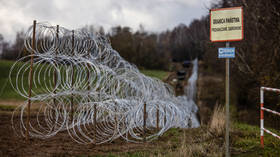EU state testing bunker designs
Estonian authorities are planning to build a defensive line along the border with Russia by 2025
Estonia is preparing to test a series of prototype bunkers, set to be part of a fortification line along its 294-kilometer border with Russia, the news outlet ERR reported on Monday.
The project is set to include 600 bunkers and is expected to cost Estonian taxpayers some €60 million ($65 million). The government is still deciding on a final design for the bunkers, and is currently considering three different models. The Estonian Defense Forces will be testing the prototypes in September by firing 155-millimeter shells at them.
The government is yet to determine the exact locations of the structures, but the procurement process for building them has already concluded. The head of the infrastructure department at the State Center for Defense Investment, Kadi-Kai Kollo, told ERR that authorities are looking to place the bunkers on state-owned land, but will also be in talks with private landowners by the end of the year.
The construction of the so-called ‘Baltic Defense Line’ was initially announced in January by Estonian Defense Minister Hanno Pevkur. Latvia and Lithuania have also joined the project.
In addition to the bunkers, the defense line is set to feature anti-tank barriers, concrete triangles dubbed ‘dragon’s teeth’, razor wire, and anti-tank mines. It is noted, however, that these devices would only be put in place in the event of a conflict.
The authorities in the Lithuanian capital, Vilnius, announced last week that they had drawn up plans to ring the entire city with anti-tank obstacles, namely steel-beam ‘hedgehogs’ and concrete dragon’s teeth structures, before the end of the year.
Mayor Valdas Benkunskas said the city expects to have the obstacles ready by the fall of this year, claiming that Vilnius is “one of the main military targets, so it is necessary to do everything possible, in addition to military measures, to protect it.”
A number of NATO countries, particularly those in eastern Europe, have recently claimed that Moscow might choose to attack a member of the US-led military bloc once the conflict in Ukraine is concluded. The alleged threat has been used by the Western leaders as justification for increasing military spending and providing additional support for Kiev.
Moscow has vehemently denied plans to attack any EU or NATO nation, dismissing such concerns as propaganda. Russian President Vladimir Putin has suggested that such claims by Western leaders are “utter nonsense and intimidation of their own population just to beat money out of them.”
You can share this story on social media:








Comments are closed.